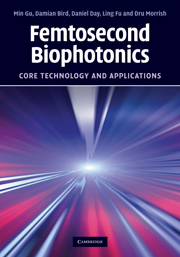Book contents
- Frontmatter
- Contents
- Preface
- 1 Introduction
- 2 Nonlinear optical microscopy
- 3 Two-photon fluorescence microscopy through turbid media
- 4 Fibre-optical nonlinear microscopy
- 5 Nonlinear optical endoscopy
- 6 Trapped-particle near-field scanning optical microscopy
- 7 Femtosecond pulse laser trapping and tweezers
- 8 Near-field optical trapping and tweezers
- 9 Femtosecond cell engineering
- Index
Preface
Published online by Cambridge University Press: 07 May 2010
- Frontmatter
- Contents
- Preface
- 1 Introduction
- 2 Nonlinear optical microscopy
- 3 Two-photon fluorescence microscopy through turbid media
- 4 Fibre-optical nonlinear microscopy
- 5 Nonlinear optical endoscopy
- 6 Trapped-particle near-field scanning optical microscopy
- 7 Femtosecond pulse laser trapping and tweezers
- 8 Near-field optical trapping and tweezers
- 9 Femtosecond cell engineering
- Index
Summary
In 1995, the first author of this book joined Victoria University. Immediately after that, he established a new research group called the Optoelectronic Imaging Group (OIG), with a focus on the introduction of femtosecond lasers into optical microscopy. While the first two-photon fluorescence microscope was reported in 1990, it was not until 1996 that the first two-photon fluorescence microscope in Australia was constructed by a group of OIG Ph.D. students with a femtosecond laser supported by the major equipment fund of Victoria University. It was this new instrument that gave the OIG research students and staff a powerful tool to conduct biophotonic research. At the beginning of 2000, most of the OIG members moved to Swinburne University of Technology to form a new research centre called the Centre for Micro-Photonics (CMP). Since 1995, research students of the OIG and the CMP, including four of the authors of the book, Damian Bird, Daniel Day, Ling Fu and Dru Morrish, have made many significant contributions to femtosecond biophotonic methods. The aim of this book is to provide a systematic introduction into these methods. Chapters 1–3, 6 and 8 were completed by Min Gu and Chapters 4, 5, 7 and 9 were written by Damian Bird, Ling Fu, Dru Morrish and Daniel Day, respectively. All the authors participated in the final editing of the book.
- Type
- Chapter
- Information
- Femtosecond BiophotonicsCore Technology and Applications, pp. xi - xiiPublisher: Cambridge University PressPrint publication year: 2010
- 1
- Cited by

